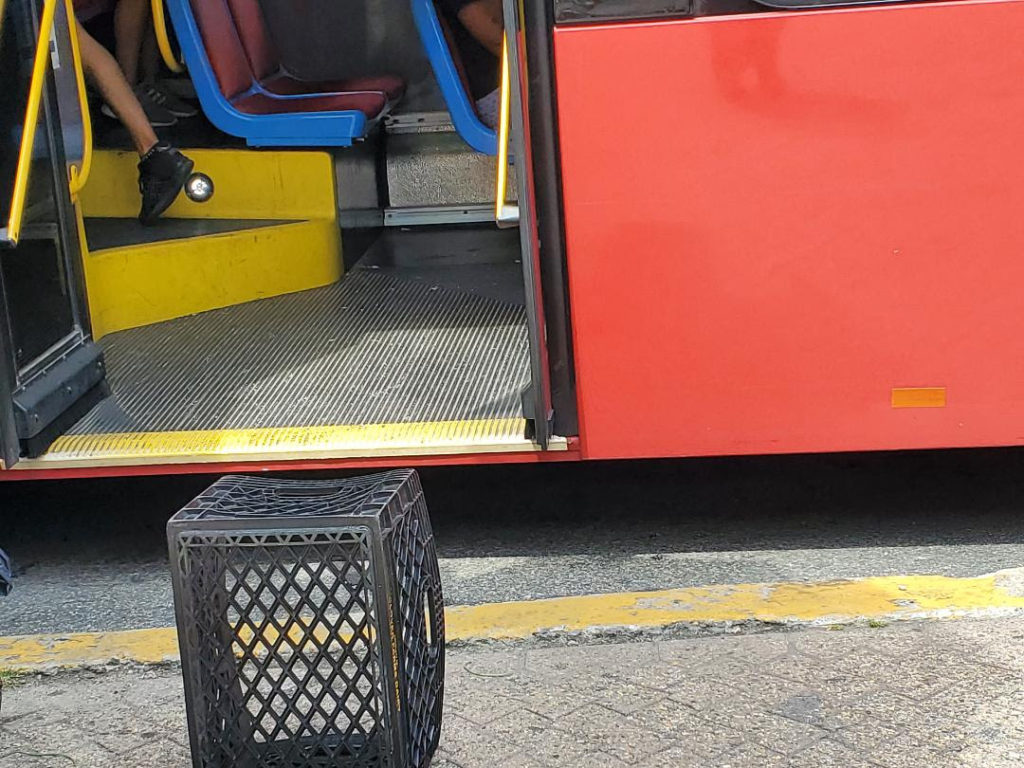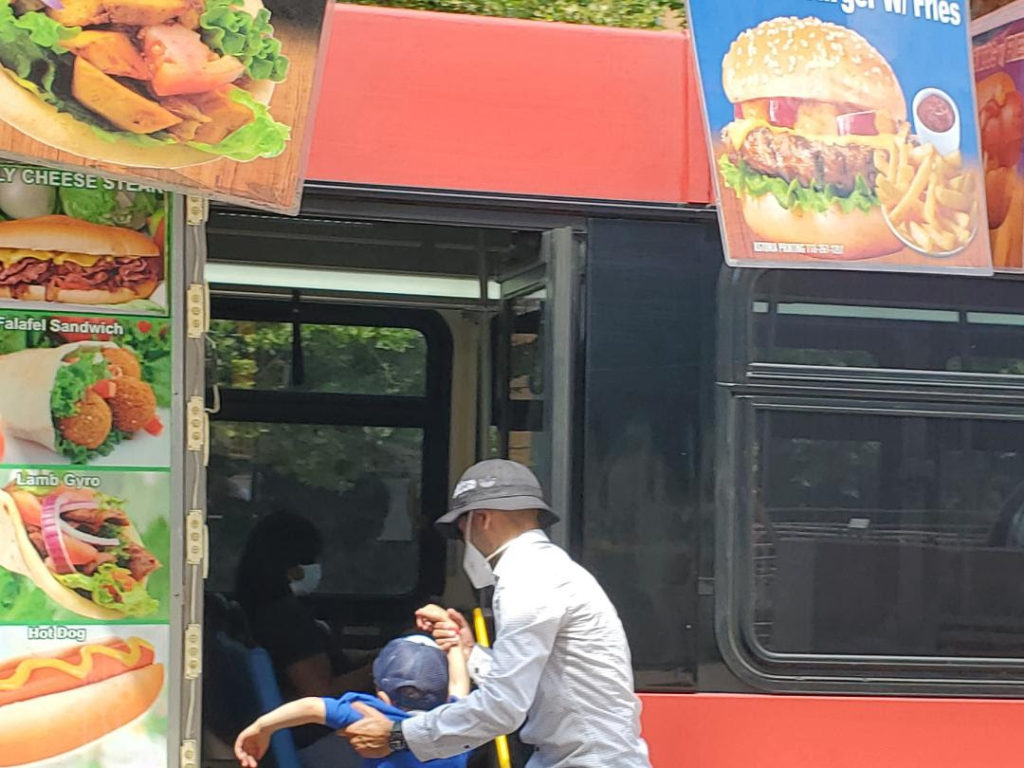Weekend, July 2-3, 2022 – MUSIC AND ARTS ENJOYED HERE FOR AGES

THE TALE OF THE HOT DOG CART

All summer this cart has been parked adjacent to the RIHS Visitor Center Kiosk. This cart has a questionable Health Department Permit and a blank price list.
We have asked PSD numerous times to have them removed away from our entrance. We also get the aroma of his propane tank and charcoal wafting into the kiosk.
PSD Captain Coleman and Chief Kevin Brown have refused to act.

All week with the tram repairs going on the cart has been around the bus stop. Today the cart was directly in the bus stop. The drivers kept complaining and nothing was done by PSD.
After watching people struggling to get on the bus we again contacted PSD. No results.

On my way home I spotted Shelton Haynes’ Chevy SUV and decided to speak to the boss in Blackwell House. He was in the house but “in a meeting.” After 3 PSD officers came to make sure I did not get to see Shelton upstairs in his private quarters, they demanded I leave and make an appointment on Tuesday to see him. It is amazing how an ordinary person must go thru numerous persons to speak to Shelton.

The PSD officers hung out in front of the house for about 15 minutes. Finally Shelton scooted out (while on the phone) into his car. He had escaped a resident. It is a shame he cannot face a resident and cares more about a hot dog vendor than an island organization, trying to do some business.
Judith Berdy

FROM THE ARCHIVES
WEEKEND, JULY2-3, 2022
THE 717th EDITION
The Day the Music Almost Died
The Naumburg Bandshell
Daytonian in Manhattan

Included in the 1851 plans for Central Park was a Concert Grounds. Calvert Vaux and his talented assistant Jacob Wrey Mould designed a fairy-tale setting consisting of fountains, wooden benches, lacy cast iron birdcages and a wisteria-entwined pergola. Central to it all was Mould’s bandstand: an oriental, cast iron pagoda-style gazebo, unveiled in 1862.

Vaux and partner Frederick Olmstead felt that “the effect of good music in the park is to aid the mind in freeing itself from the irritating effect of urban conditions.” To this end, no popular music was allowed to be performed that appealed to the baser of instincts.
As the new century neared, the parks commissioners loosened up and choral and folk music were permitted and around the turn of the century John Philip Sousa performed his marches from here.
In 1905 German immigrant and banker, Elkan Naumburg, envisioned free symphonic concerts in the park. Beginning that year Naumburg, who founded the Oratorio Society of New York, began funding the concerts. Hundreds of New Yorkers congregated in the Concert Grounds to hear waltzes, shortened operas, arias and portions of symphonies. They would often picnic on the grass and, as night fell and the gas lamps were lit, would waltz under the stars.
In 1912 the beautiful old Concert Grounds were no longer adequate for the size of the crowds the concerts attracted. Naumburg offered to donate a new bandshell and called upon his nephew, architect William G. Tachau to design one.
Mould’s unique cast iron pagoda was razed, the filigree birdcages were scrapped and the Concert Grounds paved over. Construction began on Tachau’s 1916 designs in 1921 and the bandshell was completed two years later, opening on September 29, 1923.
The striking new Naumburg Bandshell was constructed of Indiana limestone; a neo-classic half-dome with a coffered interior. Ten thousand people attended the dedication which included a 60-piece orchestra and the soprano soloist from Chicago Opera Company. Naumburg told the crowd, according to The New York Times, that “…there was nothing more to say than was contained in the inscription on the building itself: ‘To the City of New York and its Music Lovers.’”

When Eklan Naumburg died the following year, his sons Walter and George took up the cause and continued funding the Central Park concerts. Both left provisions in their wills to endow the concerts going forward.
The summer concerts were a favorite with park goers who came to hear the likes of Duke Ellington, Irving Berlin and even The Grateful Dead. In 1949 children’s writer E. B. White – author of Charlotte’s Web – called the concerts “a magical occasion. And it’s all free.”
From its stage the Reverend Dr. Martin Luther King Jr. spoke, as did Fidel Castro. And it was from here that John Lennon’s eulogy was given.
By the end of the 1980s, however, trouble was brewing for the now-aging band shell.
Lack of regular maintenance had taken its toll and the homeless, drug dealers and vandals had taken it over. Rather than restore the neo-classical dome, the Parks Commission decided to raze it. Betsy Gotbaum, Commissioner of the Parks and Recreation Department, called the bandshell “a maintenance nightmare” and The New York Times reported that “Parks officials saw the band shell…as an obsolete intrusion on the landscape.”
Despite heated protests by Elkan Naumburg’s family, preservation groups, and New Yorkers in general; the New York City Art Commission authorized demolition of the bandshell in January 1992. Naumburg’s great-grandson, Christopher London was crestfallen.
“The band shell has played an important role in the history of free public concerts and it’s part of people’s lives. To rip it down denies and eradicates that history for a misguided esthetic concept of purity that anyone who lives in New York knows doesn’t exist,” he said.
London, an architectural historian, led preservationists in a drawn-out court battle. Finally in July of 1993 the New York State Court of Appeals blocked the demolition citing a city law requiring protection of municipal gifts.
The Parks Commission was not pleased. Gotbaum grumbled, “It stands out like a sore thumb, but the band shell will stay. But we will be gracious losers and now try to make the best of a bad situation.”
She added that the Parks Commission would now try to “work around the band shell.”
Work “around it” they did. A $3 million restoration of the concert grounds was completed which did not include the band shell. It sat barely used and unmaintained for another ten years.

Still fighting in 2002, a frustrated Christopher London complained “Even though I won the court case, it was a Pyrrhic victory. It is demolition by neglect,” he said. Citing vegetation growing out of the limestone and tools stored in the back stage area he added, “They are trying to erase the memory people have of enjoying concerts here.”
The restoration costs that were estimated at $250,000 in 1993 had now climbed to as much as $2 million.
With a new administration came changes. In 2003 restoration efforts began. Structural engineer Robert Silman was brought in to assess water damage and a possible shifting of the dome. With little money available from the city, fund raising efforts were initiated by the Central Park Conservancy and other preservation groups.

Today Elkan Naumburg’s vision of free public concerts is up and running again. Among the concerts offered in his bandshell are fully-staged grand opera productions by the New York Grand Opera.
The iconic bandshell has appeared in numerous motions pictures such as Hair, I’m Not Rappaport, Breakfast at Tiffanys and Mighty Aphrodite.
Once referred to as Central Park’s “sore thumb” it is treasured by millions of New Yorkers.
WEEKEND PHOTO
Send your response to:
rooseveltislandhistory@gmail.com

FRIDAY PHOTO OF THE DAY
QUILT FROM ROOSEVELT ISLAND DAY NURSERY
GLORIA HERMAN AND ALEXIS VILLAFANE GOT IT RIGHT.

Thanks to Bobbie Slonevsky for her dedication to Blackwell’s Almanac and the RIHS
Thanks to Deborah Dorff for maintaining our website
Edited by Deborah Dorff
All image are copyrighted (c)
SOURCES
DAYTONIAN IN MANHATTAN
GRANTS
CITY COUNCIL REPRESENTATIVE BEN KALLOS DISCRETIONARY FUNDING THRU DYCD


Copyright © 2022 Roosevelt Island Historical Society, All rights reserved.Our mailing address is:
rooseveltislandhistory@gmail.com



Leave a comment